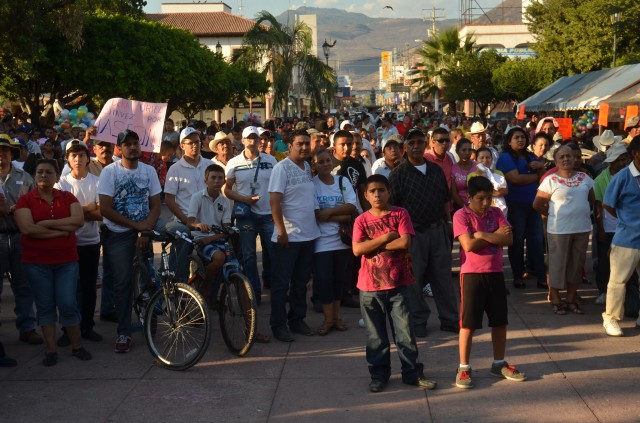For Vladimiro Carranza Chavez, a onetime Los Angeles mariachi, joining a ragtag militia to fight against one of Mexico’s most ruthless drug cartels followed a series of tragedies, including the murder of three of his brothers and his own kidnapping and torture.
“The moment came, that in order to survive, we had to fight,” he says.
Reny Pineda enlisted in the high-stakes battle against the drug lords with support from his family in California and a Colt pistol handed down from his father.
“We don’t trust anyone,” he says. “Not the government. Not the police. Just ourselves.”
Since 2012, an unprecedented uprising by motley bands of vigilantes in the Mexican state of Michoacan has put the Knights Templar drug organization on the run and forced the federal government to take firm, if belated, action to end years of gruesome violence.
Fueling the movement are thousands of migrants who lived in California and other U.S. states before returning to Mexico. Many worked on farms in the Central Valley or in factories and construction sites in Southern California before being deported or traveling back voluntarily.
Since 2010, there have been more than 160,000 deportations of Michoacanos by the Obama administration, according to Mexico's federal migration agency.
Ana Maria Salazar, a Mexican-American security analyst, says many of the migrants had developed a degree of trust in police and other civic institutions while living in the U.S., making the conditions back home all the more shocking upon their return.
“They come back to Michoacan and they find this complete warlike situation,” Salazar says. “People are getting killed, people are being disappeared, women are being raped, children are forced to work for some of these drug organizations. It’s surprising these self-defense movements didn’t pop up sooner.”
“Comandanta Lupita” (center) is one of the few women fighting in armed militia groups in Michoacan, long an epicenter in Mexico’s drug war. She explains how she joined the movement to avenge her uncles’ murders. (Alan Ortega/KQED)
California Roots of Anti-Cartel Movement
A co-founder of the civilian militias is Dr. Jose Manuel Mireles, a tall, lanky physician who embodies the movement's deep connections to California. Mireles lived with his family for a decade in Modesto, where he worked for the local Red Cross.
After moving back to Michoacan, Mireles says the Knights Templar cartel launched a brutal campaign of extortion, rape and murder. Unlike in the United States, he says there was no place to turn for protection because local authorities were often working for the cartel.
“We had nobody to help us,” Mireles says. “Then we started planning in a small group. We spent two years planning how to make something.”
Mireles’s group of informal advisers included Jose Ramirez, an old friend from the Central Valley who lives and works near Fresno. Ramirez helped raise discreet support for the movement among the hundreds of thousands of Michoacanos living in California.
“People were afraid to let others know,” he says. “It’s like who do you trust, who do you not trust.”
Some of the men who joined Mireles’ movement are unlikely warriors.
Pineda was born in Michoacan but left Mexico as a young boy when his family headed north to California. He grew up in Los Angeles, graduated from high school and started a family. He was working off and on in construction when he got caught up in a drug trafficking case. Instead of facing possible prison time, Pineda fled south across the border.
That was in 2010, just as the Knights Templar organization was tightening its grip. With the cartel extorting local businesses, ranches and farms, Pineda says it was difficult to make a living. Five friends disappeared and are among the hundreds of people believed to have been murdered by the drug gangs.
“It was terrible,” he says.
So when a group of ranchers and farmers from a cluster of nearby towns approached Pineda and his family, they decided to join.
“The most important thing was to be able to work, without paying money to somebody,” he says. "And to stop the killing.”
Reny Pineda was born in Michoacan, but grew up in Los Angeles. In 2010 he returned to Mexico at a time when a ruthless cartel was ruling the region. Standing in an orchard where he picks lemons, Pineda describes why he joined the armed movement against the cartel. (Alan Ortega/KQED)
Gaining the Upper Hand
After 18 months of fighting, the cartel is on the run. More than 30 municipalities are now under the control of the militias and federal police. And authorities have arrested hundreds of alleged cartel members as well as local politicians and police.
In May, the Mexican government announced the civilian militias were being absorbed into a new rural police corps. Vigilantes are allowed to keep their weapons in spite of Mexico’s tight gun laws, but only if they join the new force.
With the conflict winding down, at least for now, some migrants are returning to their families back in the United States.
Yet while violence in Michoacan has dropped to levels not seen in years, tensions persist. There have been violent disputes within the militia movement and allegations that some local commanders are working for rival drug cartels seeking to control heroin and methamphetamine production.
“It’s very easy for a hero to become a villain,” says Salazar. The big challenge, she says, is whether federal and state authorities can demobilize the vigilante groups, prevent a rebirth of the drug cartel and preserve the tenuous peace, using institutions such as the police and army that contributed to the violence and lawlessness in the past.
Once a mariachi performer in Los Angeles, Vladimiro Carranza Chavez now carries weapons to defend his Mexican hometown from a drug gang that once controlled the region. He describes how his battle with the Knights Templar drug cartel began. (Alan Ortega/KQED)
